Some of the links in this post may be affiliate links.
There are more Monsteras out there than the enormously popular Monstera deliciosa…and Monstera adansonii is one of them! Also known as Swiss Cheese Plant or Swiss Cheese Vine, Monstera adansonii is a much more space conscious plant.
Keep reading and I will tell you all about the care and propagation of this amazing and easy to grow plant!
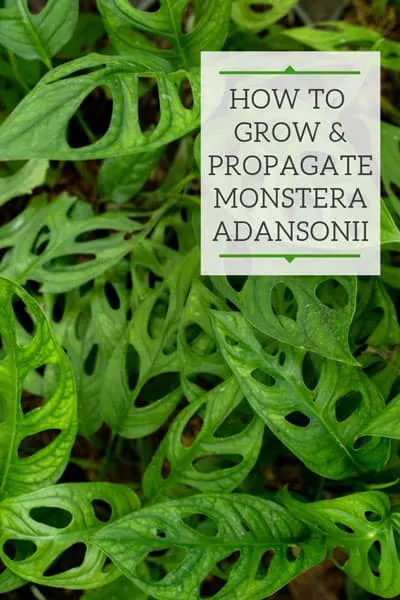
Allow me to have a rant about common names though before we talk about care and propagation.
If you do a search engine query on Swiss Cheese Plant, you will find both Monstera adansonii as well as Monstera deliciosa.
Although both Monsteras, they are completely different species. To make it even more confusing, another common name for this plant is Monkey Mask plant.
Hence, my frustration with common names! If you have been following me for a while on my blog or my Instagram (@ohiotropics), you know that I prefer to use the Latin names for plants in most cases, so Monstera adansonii it is!
Sometimes this plant is mistakenly listed under Monstera friedrichsthalii, but adansonii is the correct species name.
If you came here by accident with the intent of reading about Monstera deliciosa, please refer to my blog post Monstera Deliciosa Care: 5 Crucial Things You Need to Know.
One of the reasons I like Monstera adansonii is its ease of care, as well as its rapid growth rate. In no time, you will be propagating this plant and have more than you know what to do with!
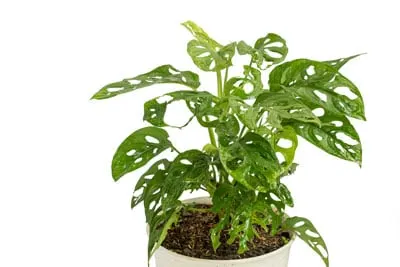
Table of Contents
FUN FACTS ABOUT MONSTERA ADANSONII
This plant is a pretty widespread climbing plant that is native to many areas in South America and Central America.
Although many times they are sold as hanging baskets, these are actually climbers! But of course you can grow these either way.
When grown with a support, such as a moss pole or wooden post or something similar, the plant will grow larger and larger leaves over time as the plant gets taller. Don’t expect this overnight though. It will take a while!
Be sure to check out my blog post on how to make your own moss pole if you are interested. They’re very high quality and better than anything I’ve been able to purchase.
Or you can just simply have it cascading down as a hanging basket. It just all depends on what you want to do. They are beautiful either way!
Remember though that juvenile leaves will have no holes. As the plant grows older, the newer leaves will develop more and more holes, which are called fenestrations.
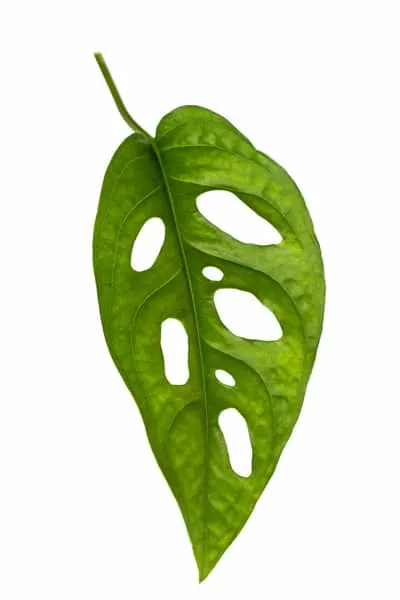
It is thought that the fenestrations evolved in order to allow the plant to be better suited to withstanding windy and wet tropical environments in nature.
Take a look at a mature Monstera adansonii growing on a tree. Notice how different the leaves look.
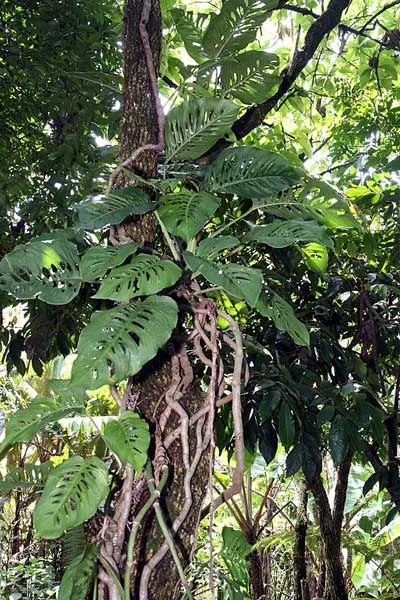
One last point before we get into the care and propagation, is that Monstera adansonii is often sold as Monstera obliqua which is a very rare and very expensive species.
Please be sure to purchase from a reputable seller to avoid scams!
I wrote a blog post on 7 ways to tell the difference between obliqua adansonii after a good amount of research and consultation with experts on the topic!
MONSTERA ADANSONII CARE
LIGHT
This plant is amazingly adaptable to many different light conditions. It is quite tolerant of lower light, but if you understand how these plants grow in nature, it will give you a clue on how to care for these plants.
Monstera adansonii, like some other species in the Monstera genus, will start off by growing at the base of a tree, and climb its way up to the canopy. At the base of a tree, the conditions will be pretty shady.
Near the canopy, there will be direct sun. So these are tolerant to different light conditions.
In the home, in order to provide the best appearance, I would at a MINIMUM place it by any window. Although these may be listed as “low light” houseplants, it just means they tolerate low light.
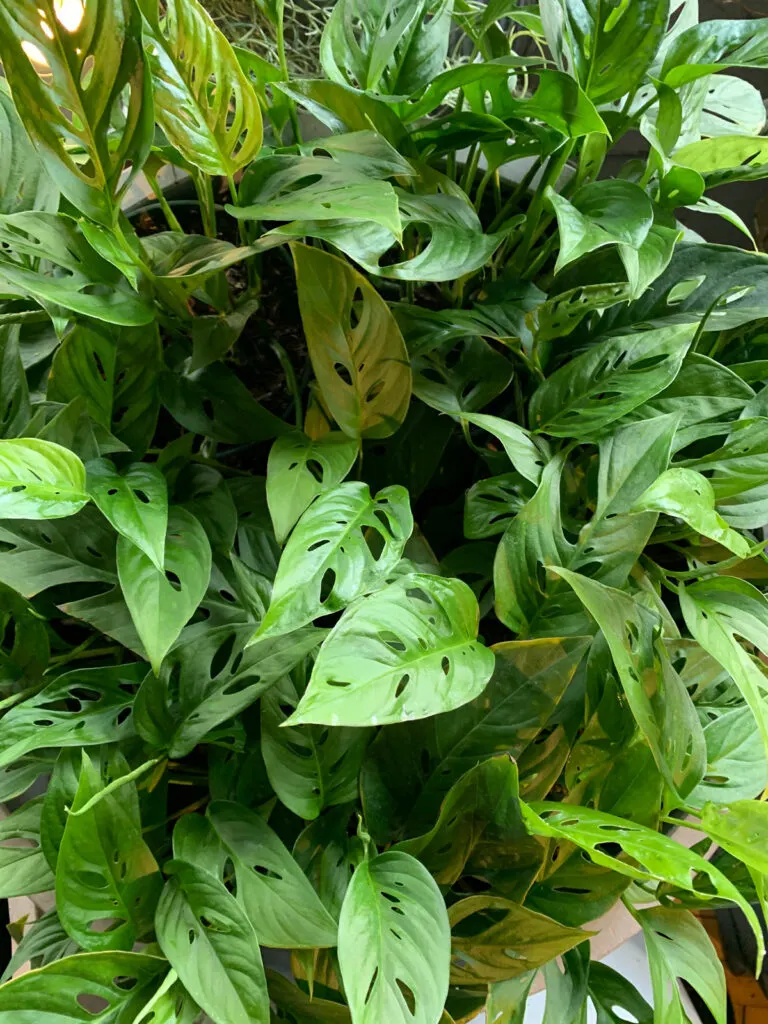
If you place these plants in a location too far from a window with dim light, they will grow very spindly. They will survive for a while, but they won’t look too great!
I have my own plant growing in front of big Northern window in our sunroom. That room also has a wall of Eastern windows and a skylight, so it gets plenty of bright indirect light, and also some direct morning sun.
I would say the best lighting conditions for these plants is bright indirect light provided by a Northern window or Eastern windows work beautifully too. Gentler morning sun can be very beneficial.
If you live in areas that have intense sun, you may want to diffuse the direct sun with blinds or a sheer curtain. Contrary to popular belief, these plants can take some direct sun! I would experiment and see what works for you.
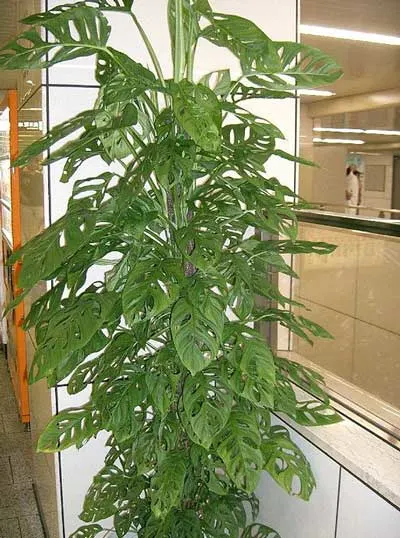
SOIL AND WATERING
The best soil for Monsteras in general are chunky, airy potting mixes. I like to mix my own blends for most of my plants.
I will share a Monstera soil recipe that I used for my Monstera deliciosa that has been working out amazingly well.
The recipe is simply 1 part #3 sized perlite with 2 parts Miracle Gro potting mix. You can even experiment and use 3 parts of the potting mix instead of 2.
This is not a magic recipe and there is no ONE soil recipe that will work. Sometimes I add a bunch of orchid bark to my mixes instead. This works equally well!
I normally have orchid bark on hand anyway since I grow tons of orchids.
But the perlite/soil blend that I mentioned works exceedingly well! The intent is to provide a nice airy mix that these plants love because it provides lots of oxygen to the roots as well as incredibly drainage.
As far as watering goes, avoid extremes. These plants HATE to go completely dry and they hate staying wet just as much.
If you let them go completely dry, a couple things will happen. You will get plenty of yellow leaves (especially at the base) and the tips of your leaves will be brown and crispy.
If you have issues with plants in general getting brown and crispy leaves, be sure to check out my blog post on the Top 6 Reasons by your leaves are turning brown and crispy.
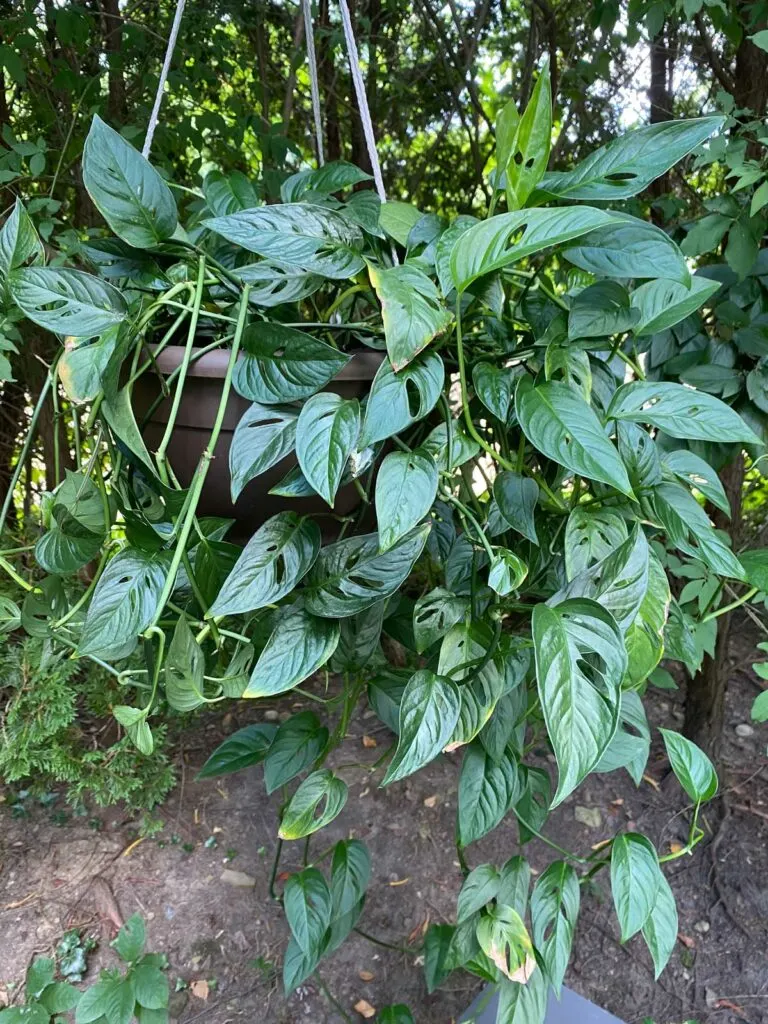
On the other hand, if they stay constantly wet, then you will increase the possibility of root rot. One of the keys to avoiding a constantly wet soil is to make sure your plant is growing in good light and that you have a nice airy potting mix like I mentioned above.
What I like to do for watering is to let the top inch or two dry out (depending on the size of your pot) and then water thoroughly. Then you would simply wait for the top inch or two to go dry again, and repeat!
It’s that simple. Just don’t go by a calendar. If you tend to be one of the “once a week” waterers, and you go to check your plant’s soil and it is still wet on the surface, don’t water. Wait a little longer.
One thing that you have to watch though is that the airier potting mixes will dry out much more quickly. This is MUCH better than your potting mix taking too long to dry out.
This is how root rot happens. When soil stay wet for too long, especially if your potting mix is not aerated properly. Wet roots for extended periods along with lack of oxygen will cause their demise.
So keep an eye on your plants! Use your finger to determine how dry your potting mix is and water accordingly.
FERTILIZING MONSTERA
I have written about fertilizers in the past and the ones I’ve recommended are great. If you’d like to simplify though and get a fantastic all-purpose fertilizer, look no further than Dyna-Gro Grow.
The link will take to you amazon and I’ve totally been converted. This is an amazing, COMPLETE and very versatile fertilizer.
There are so many benefits. It is urea free so it won’t burn your plants. You can use it very effectively as a part of your normal fertilizing routine as well as with any hydroponic growing.
The instructions for usage are very simple and right on the bottle. You will never get any nutrient deficiencies since it contains all the major macro and micronutrients.
I now use Dyna-Gro Grow for most of my houseplants as my go-to all-purpose fertilizer. The results are just fantastic.
For Monstera adansonii, and all of my foliage houseplants, I mix about 1/4 teaspoon per gallon and water with that every time I water. The directions are right on the bottle for various methods of fertilizing.
Sometimes I skip the fertilizer and water with plain water. This is mainly out of laziness though 🙂
Remember though that you should NOT use fertilizer to compensate for poor lighting conditions or poor watering practices! It will not make up for poor conditions!
PROPAGATING MONSTERA ADANSONII
In my opinion, this plant is one of the easiest plants to propagate. Just as easy as propagating pothos. In fact, the plant basically tells you what to do! Let’s take look at how.
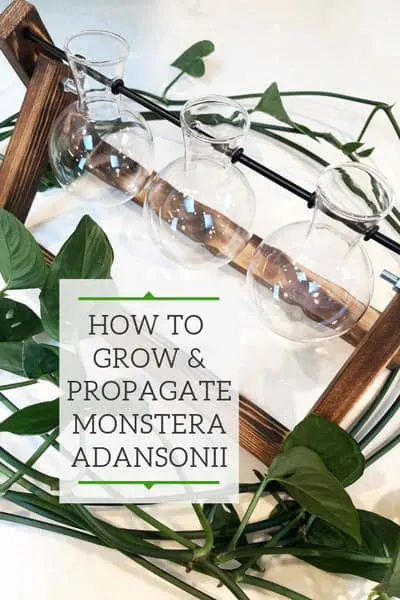
My own plant that I have was started by cuttings that were sent to me by a friend. I received them in the mail and they were slightly wilted when I received them, but they bounced back quickly.
Here is the handful of cuttings that I rooted to make my original plant.
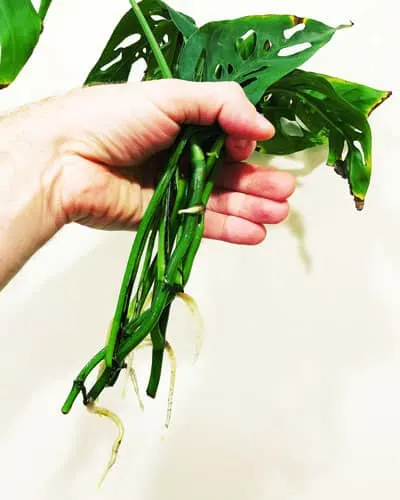
A year later, this small handful of cuttings resulted in a plant that had 10 foot vines! Let me take you step by step now into how to propagate Monstera adansonii.
The water propagation process is pretty simple! You basically want to make cuttings of the vine so that each cutting has at least one node and one leaf.
The node is where the leaf and petiole attach to the vine. In fact, chances are that you can even see roots already forming on each node. Take a look at the two roots that are already visible.
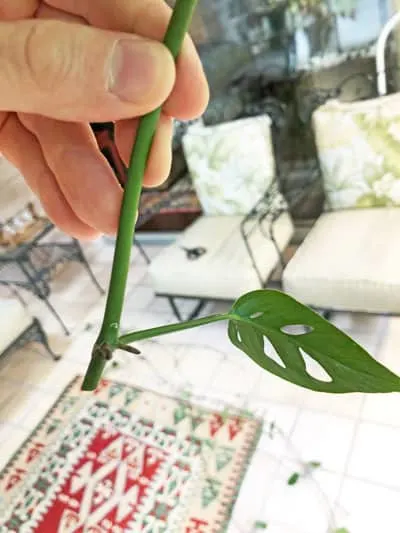
So, just start off with your long vine, and cut it into as many cuttings as you want. Here is a long vine that I’m holding up before I cut it up.
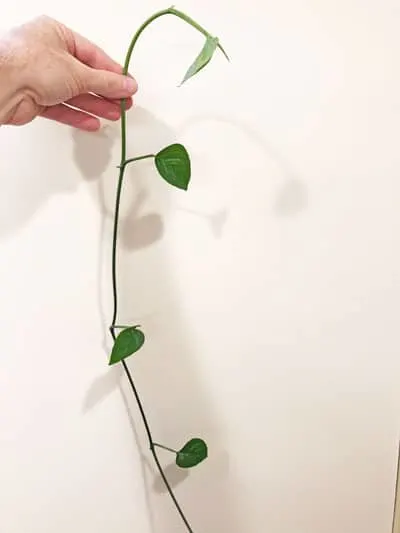
Then simply cut up as many cuttings as you want. Here is an example of where to cut. You’ll want to cut a little bit below each node.
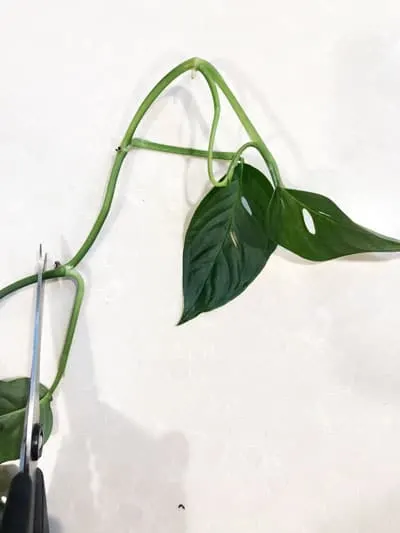
But remember to keep at least one node and one leaf on each final cutting, like in the photo below.
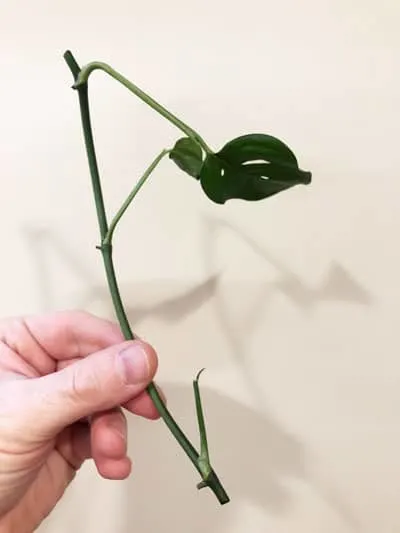
Finally place all the cuttings in a vase and change the water regularly. Bare minimum once a week. If the water appears to get dirty, then change the water more frequently.
The cuttings should root fairly quickly and should appear right at the node that is under water.
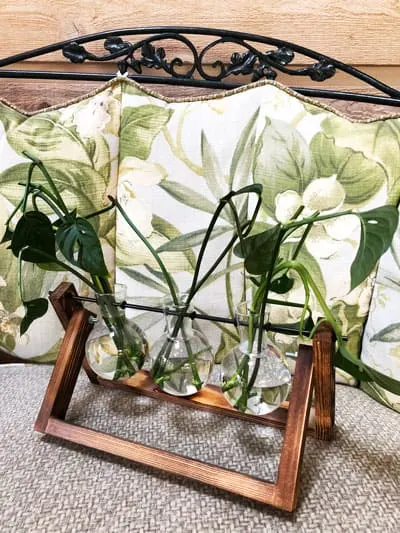
You should start to see beautiful white roots showing up within a handful of weeks or less. Once the roots are about an inch long (2.5cm) or so, you can pot them up.
If they get a bit longer, don’t worry. Pot them up anyway. So many people get so worried about the water to soil transition. Don’t be a barrier to yourself. Just do it!
I’m going to use my cuttings to plant back into the original pot that my plant is growing in, in order to make it fuller. Or you can use them to start brand new plants.
Take a look at the before and after photo below. I started out with the cuttings on the left hand side that I received from a friend, and the right side is about two years later.
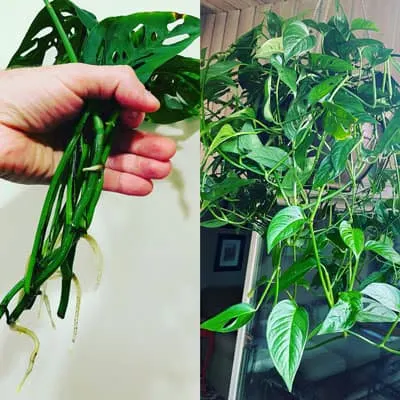
On the right side, I had even pruned that plant multiple times. With the cuttings, I planted some back into the same pot, and gave others away. It’s a really vigorous, fast-growing plant!
If you want a bushier, fuller plant from the beginning, you will have to plant several cuttings into a pot. If you only use one or two cuttings, you will be waiting forever and you may never get the look you’re going after.
If you want to create a climbing plant, check out my blog post on how you can make your own moss pole. You can easily train your plant to climb and it looks beautiful too!
If you enjoy water propagation, be sure not to miss my post on the best houseplants to propagate in water.
BEST POT FOR MONSTERA ADANSONII
You can use any type of pot for your plant, as long as it has drainage holes. Keep in mind though that the material that your pot is made of will have a big effect on how quickly your potting mix dries out.
Terra cotta pots will dry out much more quickly than other types of pots since they are extremely porous. If you use a terra cotta pot along with a very chunk potting mix, your potting mix may dry out much more quickly than you may prefer.
To learn about all the factors that affect how quickly your potting mix dries out, I want to refer you to my book, Houseplant Warrior: 7 Keys to Unlocking the Mysteries of Houseplant Care. I teach a holistic approach to houseplant care, and it will be well worth reading it cover to cover.
As far as pot size goes, as a general rule of thumb, if your plant is root bound, only go up one size.
For example, if your plant was previously growing in a 4 inch diameter pot and it is root bound, move it up to a 6 inch diameter pot and no bigger. This way your potting mix isn’t taking an excessively long time to dry out.
TEMPERATURE AND HUMIDITY
As I always say, if you’re comfortable in your home, your plants probably will be too. Keep your Monstera adansonii on the warm size and try not to go below a minimum of 60F (about 15.5C).
Native to the tropical jungles of Southern Mexico and Tropical South America, these plants enjoy high humidity, so increase your humidity if at all possible.
This is especially important if you have very dry indoor air during winter time if you are running forced air heat.
COMMON MONSTERA ADANSONII PROBLEMS
BROWN EDGES ON LEAVES
Browning leaf edges on your adansonii can have numerous causes including
- Keeping your potting mix too dry
- Keeping your potting mix too wet (to the point of the roots starting to rot)
- Using poor quality water
- Keeping your plant too root bound and struggling with keeping it well-watered.
- Overfertilizing
- Low humidity
Be sure not to miss my blog post that elaborates on all these causes of brown, crispy leaves on your plants.
YELLOW LEAVES
Much like brown, crispy leaf edges, there are numerous causes for yellow leaves on your adansonii.
The most common cause is allowing your potting mix to dry out too much for too long. In this particular case, you will see the lower leaves on the vines turning yellow before all others.
Make sure to never allow your potting mix to dry out completely for too long, if you can help it.
If you do see yellow leaves, you can gently pull them off or cut them off.
DROOPY PLANT
The most common reason your adansonii is drooping is extremes in soil moisture.
One scenario is that you left your potting mix dry out completely for too long. If this is the case, simply give your plant a nice, thorough soaking and it should recover.
The other scenario is if your plant has stayed wet for too long. Perhaps you left it sitting in water or your growing conditions didn’t encourage your soil to dry out fast enough.
If your plant has exhibited root rot, this can also cause your entire plant to wilt. You would have to inspect the root system though to determine that this was indeed the case and your roots have turned mushy and have rotted.
In this case, try and salvage the plant by repotting it into a fresh potting mix and into a smaller pot.
MOSAIC VIRUS
All too often, people think their plants are plagued with mosaic virus. Plants that have mosaic virus are characterized by mottled leaves that are a different color than your leaf is supposed to be (yellow, white, etc.) and appear as either spots or streaks in the foliage.
Your plant’s growth may also be stunted and leaves can grow in twisted and deformed.
If you suspect that your plant may have mosaic virus, isolate your plant and quarantine it from your other plants.
The only way you’ll know if your plant has mosaic virus is if you have your plant tested. You can take a foliage sample to your state’s local USDA extension office, or maybe even an extension office of your state’s Master Gardener organization.
If you are looking for other species of Monstera to grow (and there are LOTS), check out my post on 15 Amazing Monstera Varieties to add to your collection.
That’s it folks! I hope you’ve enjoyed this blog post and comment below if you have an Monstera adansonii!

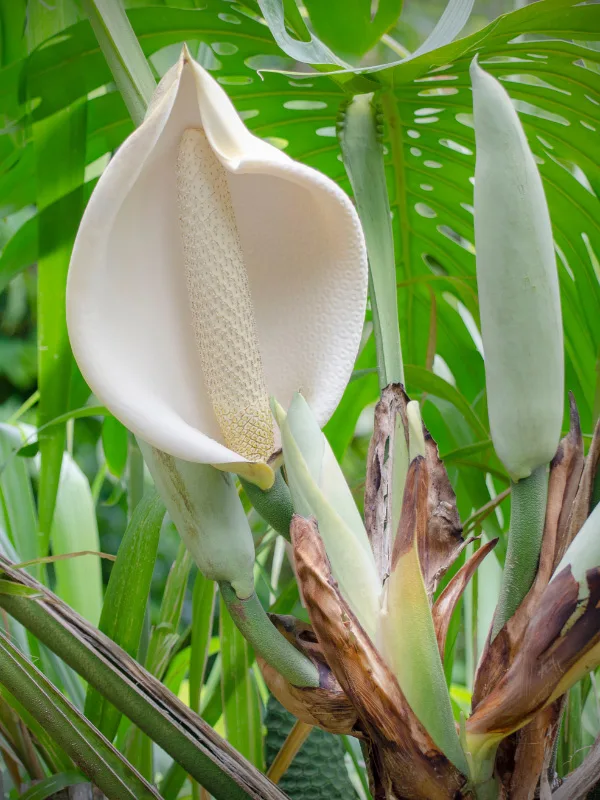
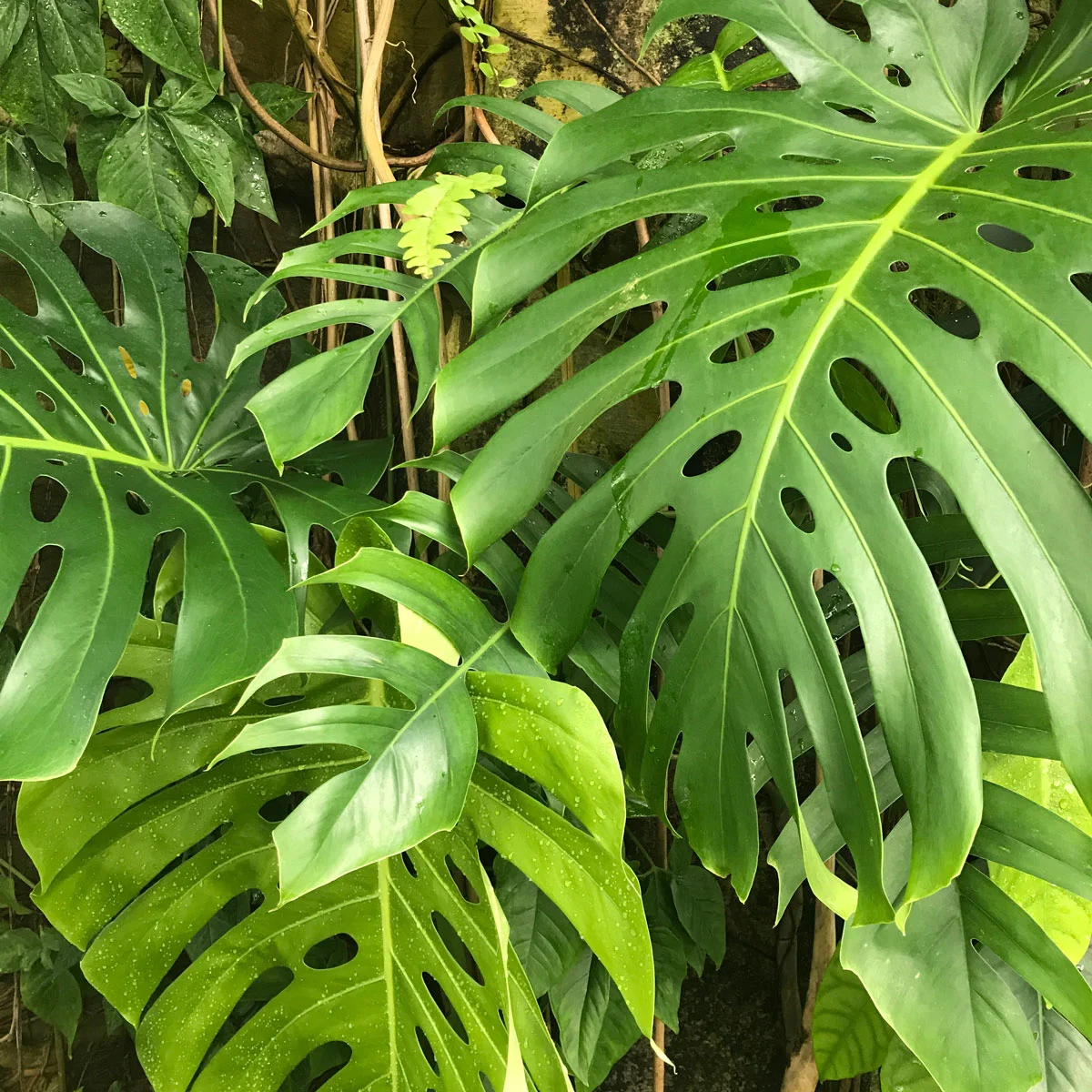
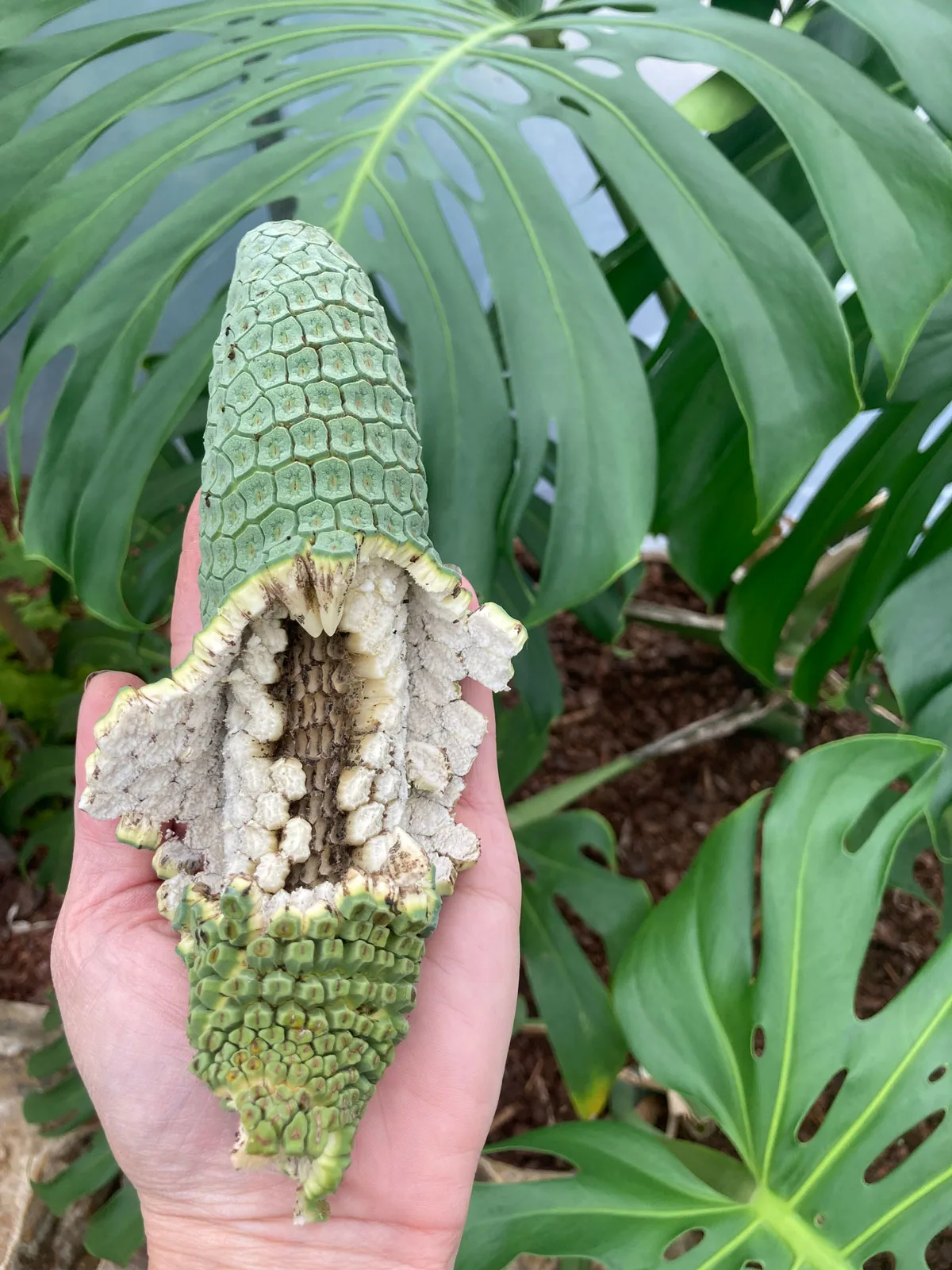
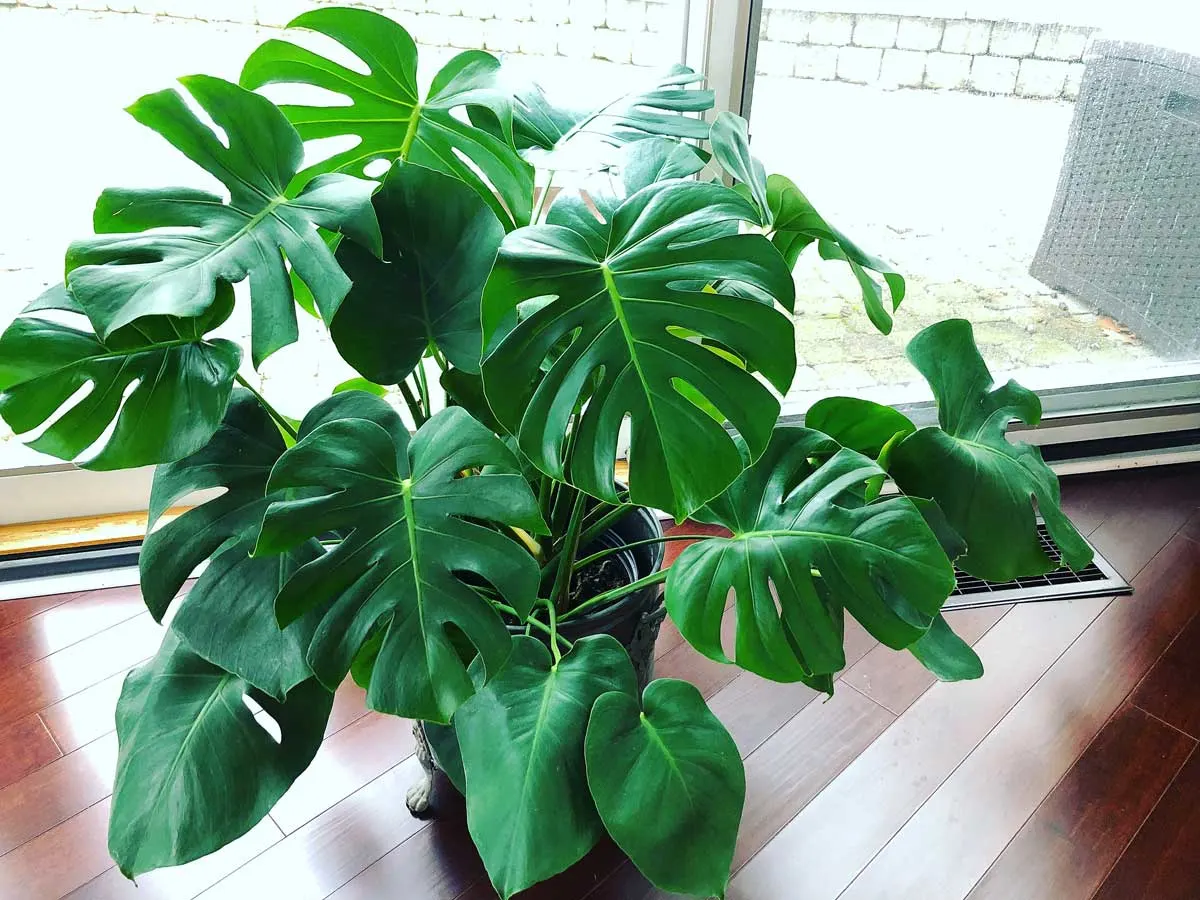
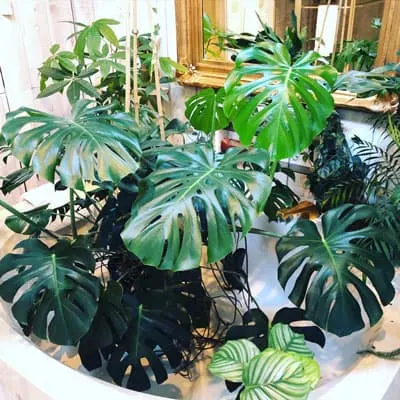
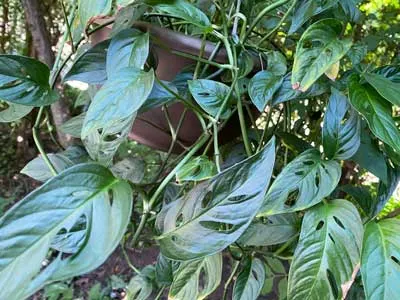
ella
Thursday 12th of October 2023
Thank you for sharing! I find your article insightful for a beginner like me. I'd like to ask for your recommendation on how to go about saving a thick and slightly dry vine. I have one that I thought died, but it is still green just with dry edges on old leaf lines, and recently grew a small node, should I leave it be to grow at its own pace or take it out and propagate it or fertilize the soil? currently, it is with a growing monsterra adansonii single vine pot.
Raffaele
Thursday 12th of October 2023
Glad it was helpful Ella! I would try and nurture your plant as is right now and wait it out. Once it perks back up, you will have plenty of material to propagate :-)
Jane
Tuesday 11th of April 2023
Do you recommend baking your soil to kill pests before using? If so, what temp and for how long? Thanks so much. Appreciate all the info here.
Raffaele
Thursday 13th of April 2023
In general, it's not needed, but if you are suspicious, the general recommendation would be to bake at 180-200F for 30 minutes.
Denise
Wednesday 25th of August 2021
Thanks for the post. I’m having some trouble with M. adansonii despite having over 20 years experience successfully growing houseplants. I bought a decent size plant and split it into a hanging plant and a climbing one. Climbing one was doing great at first but now not growing much and getting yellow leaves. Seemed to get yellow leaves after maybe watering a bit too often AND after letting dry out more (but not totally dry). Also getting vines with no leaves. It was in front of a south window but moved it because thought too much light may be the problem. It’s now in front of a west window with blinds to control sun (gets filtered direct light in afternoon. Seeing maybe a new leaf on one vine but nothing on the other. Haven’t fertilized every time I water but prob do once a month at least. Any advice? Getting frustrated with this one.
Raffaele
Thursday 26th of August 2021
Hi Denise! Is it possibly root bound? Can you describe how you're watering, and how you're determining when to water? Once I have those details, it will help me help you more. Vines with no leaves can occur when there is too little light.
Dawn
Wednesday 21st of July 2021
Hi, I keep trying to propagate my plant and the leaves keep turning yellow/brown. There’s definitely a node below the leaves (I’ve done it with 2-3 leaves per cutting). The plant is healthy. It’s in a very sunny kitchen window, is this the reason? Help please!
Raffaele
Wednesday 21st of July 2021
Hi Dawn! Try putting your cuttings in a bright location, but not in direct sun. A little morning sun would be fine, but avoid all day sun, especially mid-day sun which is very strong. Hopefully this helps!
Jodee
Sunday 11th of April 2021
Hi, absolutely love this post, found you on Pinterest. So helpful! One quick question! Where did you find your three vase thingy for propagation? I need it! Thank you so much!
Raffaele
Monday 12th of April 2021
Glad you enjoyed it! I don't remember the name of the company for the propagation unit since that was a while ago! I'm not really that happy with that one. It is poorly designed and constructed, though it appears nice in the photo. I do have a relationship with a company that makes amazing units. If you visit https://modernbotanical.shop/ and use code OHIOTROPICS, you will get 20%. They're pricier than many, but they're absolutely amazing and super high quality. They have single, double, and triple units. I would highly recommend those :-). I have several.